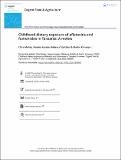| dc.contributor.author | Mollay, Clara | |
| dc.contributor.author | Kassim, Neema | |
| dc.contributor.author | Stoltzfus, Rebecca | |
| dc.contributor.author | Kimanya, Martin | |
| dc.date.accessioned | 2021-05-03T05:56:29Z | |
| dc.date.available | 2021-05-03T05:56:29Z | |
| dc.date.issued | 2020-12-24 | |
| dc.identifier.uri | https://doi.org/10.1080/23311932.2020.1859047 | |
| dc.identifier.uri | https://dspace.nm-aist.ac.tz/handle/20.500.12479/1155 | |
| dc.description | This research article published by Taylor & Francis Online, 2020 | en_US |
| dc.description.abstract | Aflatoxins (AFs) and Fumonisins (FBs) are common contaminants of maize, from secondary metabolites of fungi. Presence of AFs and FBs in maize-based complimentary food is evident in various studies conducted in Tanzania and elsewhere. Consequently, Infant and Young children (IYC) aged between 6 and 24 months in Tanzania who consume monotonous maize-based foods are at a high risk of exposure to these toxins. The AF or FB exposures have been linked to low awareness and inadequate knowledge or limited skills of IYC feeding practices among mothers and caregivers. This review reveals that more researches are needed to identify appropriate feeding practices in Tanzania to improve child growth. Meanwhile, stakeholders should direct efforts on education to subsistence farmers including mothers and caregivers on interventions to minimize mycotoxin contamination of cereal and nut-based complementary foods in the country. | en_US |
| dc.language.iso | en | en_US |
| dc.publisher | Taylor & Francis Online | en_US |
| dc.subject | Mycotoxins | en_US |
| dc.subject | Feeding practices | en_US |
| dc.subject | Fumonisins Tanzania | en_US |
| dc.title | Childhood dietary exposure of aflatoxins and fumonisins in Tanzania: A review | en_US |
| dc.type | Article | en_US |

